Posted by Elena del Valle on May 30, 2012
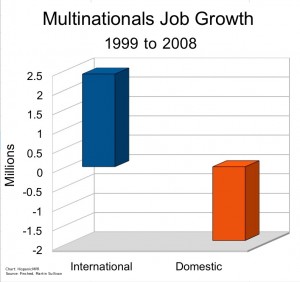
Multinationals Job Domestic and International Growth 1999-2008 – click to enlarge
It used to be that the pace of innovation kept employment numbers strong in the United States. As some jobs became obsolete and migrated overseas workplace evolution and new technologies resulted in the creation of new jobs that outpaced the losses. Over time, as innovation slowed, more jobs migrated out of the country than were created and access to cheap international human resources and continuous corporate desires for profit continue to fuel the trend with few or no tax consequences to stem the job losses.
In 2007 multinational companies employed 19 percent of the private sector workforce, earned 25 percent of private sector profits and paid 25 percent of private sector wages. For all their impressive presence and efficiency these companies were not noteworthy on the job creation side, according to a 2010 McKinsey Global Institute report cited in Pinched.
In the last 20 years, multinationals have been responsible for 41 percent of labor productivity in the United States corresponding to only 11 percent growth of employment in the private sector. The production cycle many relied on meant initial production in wealthy nations with abundant innovation that eventually moved to countries with lower labor costs. In the United States, hardware manufacturing and data processing jobs shrunk when both were expected to grow.
At the same time, and especially during the Great Recession, companies pushed for greater efficiency, driving staff to work longer hours and accomplish more with less. Some developed new processes and methodologies and others accomplished their efficiency goals by squeezing more hours and labor out of employees who feared for their jobs and way of life in a declining economy. These strategies have led to greater stock value for publicly traded companies and higher profitability for many companies overall at the expense of jobs lost that will likely never be recovered. Fewer jobs lead to a slower economy with consumers holding back and focusing on savings. This is especially true when prospective employees are trapped where they are living due to the lingering housing bubble.
An example of the trend is that between 1999 and 2008 multinationals in the United States cut back domestic employment by 1.9 million while boosting foreign employment by 2.4 million, according to economist Martin Sullivan (see Pinched and U.S. Multinationals Moving Jobs to Low-Tax, Low-Wage Countries at Tax.com). At the same time, the figures that reflect a domestic decrease in jobs do not appear to include loss of revenue domestically for individuals who suffered salary and benefits cuts by their multinational employers.
Posted by Elena del Valle on May 22, 2012
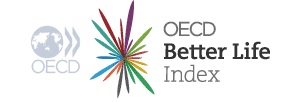
Graphic: Organization for Economic Co-operation and Development (OECD)
As we struggle in our day to day lives few of us stop to ponder the big picture. Are we happy? What does it take to have a good life? Is it education, money, a good balance of work and life, safety? Policy makers ask additional questions such as, do men and women want the same things when it comes to living well? Do people in different countries, even neighboring countries, share views about the common elements that lead to a high quality of life?
In 2004, the Organization for Economic Co-operation and Development (OECD) began to explore meaningful ways to establish quality of life. For the past two years the OECD has been looking a quality of life issues beyond just economics and gross domestic product (GDP) with the mission to “develop better indicators for better policies for better lives.”
Last year, for the first time, it released the results of its Better Life Index (BLI) in which researchers examined 11 indicators among 34 members of the organization including the United States and: Australia, Austria, Belgium, Canada, Chile, Czech Republic, Denmark, Estonia, Finland, France, Germany, Greece, Hungary, Iceland, Ireland, Israel, Italy, Japan, Korea, Luxembourg, Mexico, Netherlands, New Zealand, Norway, Poland, Portugal, Slovak Republic, Slovenia, Spain, Sweden, Switzerland, Turkey and United Kingdom.
To date one million visitors from 184 countries have visited the website to find out about the quality of life in the nations profiled. OECD staff looked at and shared their main findings about 11 Better Life Index dimensions: housing, income, jobs, community, education, environment, civic engagement, health, life satisfaction, safety, and work-life balance in 34 countries with the goals of developing good policies, allowing people to compare results, empower the public and make the information accessible. Those curious to know how their country compares with others among the 34 nations can see the latest results which become available today at http://oecdbetterlifeindex.org/
The top three drivers of well being were education health and life satisfaction and, according to their findings, there were only minor goal differences by gender. Across the board men work more and earn more. At the same time, women live longer, study more, are more social and in some countries are happier.
This year, Denmark had the highest life satisfaction and the highest work life balance, Switzerland was the country with the best health results, Finland showed the highest results in education, and Japan the highest results in security. The United States had the best ranking for income and housing.
Last year, 173,862 people visited the site from the United States; the cities with the highest participation were in descending order, New York, Washington, Chicago, San Francisco, Seattle, Los Angeles, Houston, Portland, Austin, and Boston.
The data used for the report came from the OECD or National Accounts, United Nations, and national statistics offices. Some were sourced from the Gallup World Poll, a division of the Gallup Organization that conducts public opinion polls in 140 countries around the world.
The mission of the Organisation for Economic Co-operation and Development (OECD) is to promote policies that will improve the economic and social well-being of people around the world.
Posted by Elena del Valle on May 16, 2012
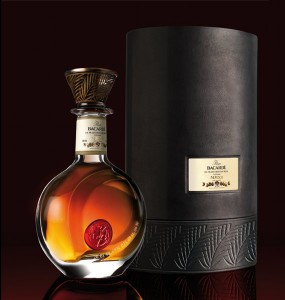
Ron Bacardi de Maestros de Ron, Vintage, MMXII – click to enlarge
Video, photos: Bacardi
Earlier this year Bacardi, the international rum making giant, celebrated 150 years of operations with displays, parties, and a family reunion. Although the top selling Bacardi product in the United States is Grey Goose to mark the occasion the company announced Ron Bacardi de Maestros de Ron, Vintage, MMXII, a limited edition Bacardi blend the combined effort of eight Bacardi family members and former rum masters (maestros de ron). Scroll to watch video about Ron Bacardi de Maestros de Ron, Vintage, MMXII.
A “blend of the finest rums laid to rest in oak barrels over the last 20 years and finished in 60-year-old Cognac barrels,” the liquid, bottled in a hand-blown crystal decanter made in Mexico then housed in a leather case, retails for $2,000. At its release only 400 decanters were available for purchase at some airports and premium retail shops.
“We had the privilege of working with some incredible stocks of aged rum. We were looking for woody notes and fruity notes. We were looking for the balance and equilibrium that makes a great rum. The depth of flavor and character that this rum has is incredibly unique,” said Guillermo Garcia Lay, Bacardi Family master blender.
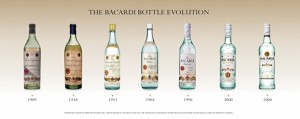
Bacardi bottles evolution – click to enlarge

Bacardi Bat evolution – click to enlarge
“I had an idea of what this rum should be and so did the other master blenders, so we tried to come up with one single Bacardi rum that would be good for all of us. And I think that if it is good for us, I think it will be good for everybody,” said Emilio Bacardí Bravo, Bacardi Family master blender.
The MMXII Vintage is described as “a highly aromatic, full-bodied and generous rum with a mellow flavor.” It is said to have an expansive nose with tropical fruits and sweet floral aromas, balanced with soft vanilla and a smooth oak character and enriched with notes of sweet Caribbean honey and fragrant fruits leading to a “long, pleasing finish with a smooth background of oak.”
The hand-blown crystal decanter was designed to represent El Coco, the coconut palm planted at the entrance of the first company distillery in Santiago de Cuba by the founder’s son 150 years ago. Etched onto the crystal decanter, next to the hand-pressed red crystal bat image, are the coordinates of 20 01 48.69N 075 49 56.86W that mark the birth place of the company rum in Santiago de Cuba. The decanter also features a map of the Caribbean pointing to the original distillery.
Founded on February 4, 1862, and family-owned for the past seven generations, Bacardi employs nearly 6,000 people, manufactures its brands at 27 facilities in 16 markets on four continents, and sells in more than 150 countries.
Posted by Elena del Valle on May 9, 2012

Young women drive a Ford Mustang convertible
Photos: Ford, General Motors
Sellers of products or services offline in old style brick and mortar offices and stores, especially those targeting a young demographic, may be interested to know that fewer young people have a driver’s license today than did their counterparts in the early 1980s, according to a University of Michigan study released December 2011. That means young customers without a driver’s license instead of self driving to visit an office or store have to rely on other means such as mass transportation, online shopping, and friends and family who have a car and drive.
The driver’s license study findings seem to match the declining sales of used cars, traditionally bought by young adults, young couples with children at home and married couples with adult children at home (they spend 72 percent more on average*). Average household spending on used cars dropped 30 percent between 2000 and 2007, according to *Best Customers Demographics of Consumer Demand.
While only 22 percent of drivers today are teenagers or in their twenties in 1983, one third of licensed drivers in the country were under 30 years old. That year, more than half of people with driver’s licenses were under 40 years of age and today less than 40 percent of drivers are under 40. The study authors did not analyze information by ethnicity or race.
Emerging market segments are well represented in young demographics. At the same time, Asian, Hispanic and black consumers spend more than the average household on mass transportation and spend less than the average household on transportation in general (Household Spending Who Spends How Much on What).
The researchers in Michigan believe there is a link between the decrease in driver’s license owners and the popularity of texting and electronic devices, activities and products that are popular among young Americans. Emerging market members tend to over index in their consumption of such products and electronic communication methods.
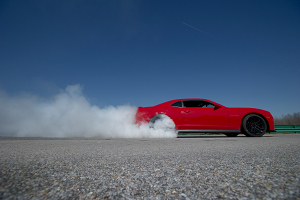
Sports cars like the GM Camaro 2012 may inspire people to get a driver’s license
“It is possible that the availability of virtual contact through electronic means reduces the need for actual contact among young people,” said Michael Sivak, research professor at the U-M Transportation Research Institute. “Furthermore, some young people feel that driving interferes with texting and other electronic communication.”
Sivak and Brandon Schoettle, a University of Michigan Transportation Research Institute colleague, examined the changes from 1983 to 2008 in the percentage of persons with permits to drive by age in a study in the journal Traffic Injury Prevention. They believe that there are fewer young people among all of today’s licensed drivers, and that young drivers are a smaller portion of their age group as a whole, compared to 1983.
That year, 87 percent of 19-year-olds had a permit to drive while in 2008 only 75 percent did. Likewise 80 percent of 18-year-olds had a license in 1983 and only 65 percent had one in 2008; 69 percent of 17-year-olds had a license in 1983 but only 50 percent did in 2008; and 46 percent of 16-year-olds had one in 1983 but only 31 percent did in 2008.
In 2008, people 70 and older were part of the largest group of drivers on the road, representing more than 10 percent of all drivers and a slightly higher percentage than those in their 40s or 50s. By that year licensed drivers as a percentage of their age group population had increased for all groups over 45 years of age since 1983. In 2008, 94 percent of those aged 65 to 69 and 78 percent of those 70 and older had drivers licenses, up from 79 percent and 55 percent, respectively, in 1983.
Some believe the recession, the cost of owning a car, migration trends toward large urban centers and the popularity of social media may account for some of the decline in driver’s permits among young Americans.
Looking internationally Sivak and Schoettle identified a similar pattern of a decrease in young drivers in seven countries and a contrary pattern in another seven countries in a subsequent study released this year, Recent Changes in the Age Composition of Drivers in 15 Countries. They concluded in their analysis that “higher societal wealth, older population in general, and higher proportion of population living in megacities were each associated with higher licensure rates among young persons.” In that study, they found that the more internet users present the lower licensure rates among youth.
Posted by Elena del Valle on April 25, 2012
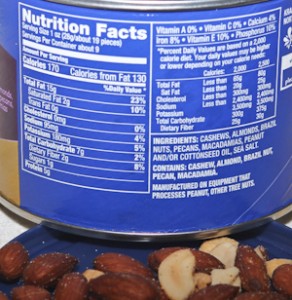
Many survey respondents said they examine the Nutrition Facts Panel in products when shopping
Photo: HispanicMPR
Any restaurant or company selling food or meals today must be aware of American’s changing tastes and opinions about healthy choices in order to adjust selections on offer and promotions.
Salt seems to be on consumers radar lately. More than half of consumers (52 percent) who responded to a Mintel survey indicated they were watching their diet. While 60 percent said they were doing so to loose weight 15 percent said they had concerns about “salt intake.”
While more than half, 51 percent, said they always or usually monitor fat content, 47 percent of respondent said they look at sugar levels, and 49 percent said they always or usually examine calorie counts when shopping; about 44 percent of respondents said they look at the Nutrition Facts Panel (NFP), and may also examine the ingredient list with special attention to salt levels before making a food purchase.
“The relatively high incidence of dieting in the US is one key factor driving demand for low-sodium products,” said Molly Maier, senior health and wellness analyst, Mintel. “Our findings indicate that fat and calorie counts are more likely than sodium to influence purchase. Thus, companies may be able to maximize the appeal of low-sodium foods by also showing, where appropriate, that they are low in fat and calories.”
Many respondents to the Mintel survey (62 percent) said they believe food makers are responsible for disclosing how much sodium is in their products, while only 35 percent said they thought the government is responsible for disclosing such information. Surprisingly, 18 percent said they thought such disclosures are the responsibility of retailers.
Although consumers seem to want to know what is in the food they buy those who responded to the survey didn’t seem to want someone else to decide what they should eat. Only 46 percent of respondents said manufacturers should adopt sodium restrictions, and fewer still, 34 percent, said the government should do so.
Instead, they said they were limiting their salt intake at home. More than half, 59 percent, of the survey takers said they always or usually limit salt consumption at home, and 44 percent said they always or usually do so when dining at a restaurant.
More women (80 percent) than men (67 percent) who took the survey said they limit the amount of salt they cook with at home. Mintel researchers concluded that retail promotional materials should often be directed at women.
Older adults who participated in the survey expressed more concern for sodium levels in the foods they eat: 33 percent of respondents 65 and older said they watch salt levels compared to 32 percent for respondents aged 55 to 64 and 22 percent of all respondents.
Posted by Elena del Valle on April 18, 2012
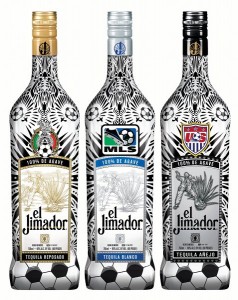
El Jimador tequila bottles – click to enlarge
Photos: El Jimador
El Jimador, a premium Mexican tequila brand, announced it hired Alexi Lalas, a former United States soccer player, to strengthen brand awareness by making special appearances and supporting the brand’s social responsibility initiative this year.
“Alexi brings more than just soccer knowledge to the table. He exhibits real passion, something that we value in our tequila production as well,” said said Jesus Ostos, tequilas brand marketing group manager. “Additionally, we wanted to work with someone who could promote our corporate social responsibility initiative and Alexi’s background affords us a level of credibility, while simultaneously increasing awareness of our presence in the sport.”
El Jimador is available in three varieties: Blanco (white), a clear tequila that is bottled after distillation. It is said to have “subtle cooked agave taste and hints of citrusy sweetness” that make it a good choice for tequila cocktails; Reposado (rested) adopts a “golden color” after sitting in white oak barrels for two months. It is said to have “hints of vanilla and caramel, a smooth and mellow taste;” and Añejo (aged), made from 100 percent tequilana weber blue agave and aged 12 months in toasted white oak barrels. It is said to have flavors of “vanilla and oak, balanced with subtle cues of cinnamon and caramel.” The tequila is available in 750 milliliter bottles at 80 proof. Bottles range in price from $19.99 to $29.99.
“We activate on a variety of levels from games on-site advertising, commemorative soccer bottles, to an experiential component for consumers. As part of our soccer platform, we will have a strong presence at all of the Mexican National Team’s games throughout the 2012 U.S. tour and will activate at various Major League Soccer (MLS) events, as well,” said Ostos when asked about promotional efforts for the brand.
“For example, we recently activated at the Mexico vs. Colombia match at Miami’s Sun Life Stadium. Consumers were invited to participate in a shoot out game to determine the fastest and most accurate kicker; consumers received autographs from soccer icon Jared Borgetti, signed up for a chance to win an autographed barrel, and took photos alongside brand ambassadors holding a giant bottle of el Jimador. In addition, in February of 2012 el Jimador launched a series of commemorative soccer bottles featuring soccer ball motifs blended with the brand’s iconic graphic designs, and highlighting the logos of Mexican Soccer, U.S. Soccer and MLS. The brand aims to distribute the packaging once a year for a limited two-month period, to kick off the soccer season in key markets nationwide.”

Alexi Lalas will make special appearances for El Jimador
Marketers for the brand seek to leverage agency partners to support the spokesperson launch through public relations and digital marketing with ESPN.com and MLSsoccer.com. Plans are to promote certain campaigns using social media on Facebook to reach customers and prospects through a two-way dialogue while other campaigns will be promoted via broadcast media.
“We measure success by an increase in brand recognition and preference among our target audience and continuous and relevant consumer programming with retailer partners,” said Ostos when asked how the brand will measure results. “Success also means that el Jimador Tequila as a brand will be identified as being socially responsible and passionate about soccer.”
Lalas is a sports analyst and a retired American soccer player and former member of the United States National Team during the 1998 and 1994 World Cups, as well as a member of the 1996 and 1992 United States Olympic Teams. In 2004, after a 10-year career, he retired from soccer. In 2006, he was elected to the National Soccer Hall of Fame.
Part of Casa Herradura, established in 1870, el Jimador is a 100 percent blue agave tequila named for the men who harvest the agave in Mexico. The tequila is produced in the tiny town of Amatitán, Jalisco in the heart of Mexico’s tequila region, and crafted using traditional methods, such as cooking the agave in clay ovens and fermenting the beverage naturally with wild yeast designed to create “a rich, smooth and unexpected taste.” According to Ostos, El Jimador is the top selling tequila in Mexico.
Posted by Elena del Valle on March 19, 2012
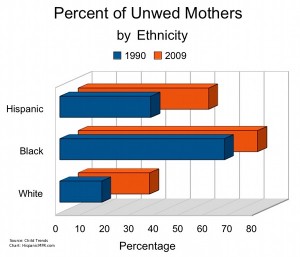
Unwed Mothers in the United States – click to enlarge
When it comes to marriage there are clear distinctions between ethnic and racial groups. It seems white and Hispanic women are more likely to ever marry than are black women. At the same time, Hispanic women who marry tend to do so at a younger age than do women of other ethnicities, according to information provided by a research scientist at Child Trends, a Washington, D.C.-based nonprofit, nonpartisan research center that studies children at all stages of development.
Researchers estimate that more than half of all births outside of marriage are to cohabiting couples. Sixty-five percent of nonmarital births to Hispanic, 61 percent to white and 30 percent to black women are to cohabiting couples. Hispanics living together with children tend to be more stable unions over time than couples of other ethnic backgrounds.
When it comes to having their first child there are also differences. For example, the average age at first birth for white women is 26 years compared to 22.7 years for black women and 23.1 years for Hispanic women. Hispanic women have, on average, more children than do white or black women.
Over the years more women having been having children without being married. In 1990, 17 percent of all births to white women, 67 percent of all births to black women, and 37 percent of all births to Hispanic women were outside of marriage. By 2009, 29 percent of all births to white women, 73 percent of births to black women, and 53 percent of births to Hispanic women were outside of marriage, according to the Child Trends data.
Posted by Elena del Valle on March 7, 2012
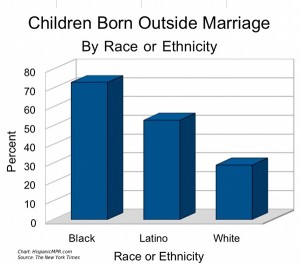
Children Outside Marriage Trends – click to enlarge
Sellers of products and services to married couples having children likely have noticed their target audience has changed significantly in the past few decades. In 2009, in the United States, although 59 percent of women married before having children when it came to younger women more than half had children out of wedlock. Also, two thirds of children were born to women under 30 years old, according to new federal data on births and marriages and Childbearing Outside of Marriage: Estimates and Trends in the United States, a research brief from Child Trends.
In the United States, although 52 percent of the out of wedlock births are to parents living together such unions are less stable than marriages; and children born to unwed mothers are more likely to be poor, fail in school and suffer from behavioral problems, according to Child Trends, a nonprofit, nonpartisan research center that studies children.
From a big picture perspective 92 percent of college educated women are married when they have a child while 62 percent of women with some post-secondary studies, and 43 percent of women with high school diploma or less are married when they give birth. At the same time 73 percent of black children are born to unwed mothers, while 53 percent of Latino children and 29 percent of whites are born outside marriage.
Being born to a single or unmarried mother went from being the exception 30 years ago to being common today. In 1980, the likelihood that a child would be born to unmarried parents was 18 percent; now it is 41 percent.
“It is hard to say what will happen. However, preliminary data from 2010 show a slight decline in the percentage of births occurring outside of marriage. It is possible that we have reached a plateau, or perhaps levels will continue to decline. We won’t know for several more years. Nonetheless, levels of nonmarital childbearing remain high and I don’t really expect that we will see a huge surge in marriage anytime soon. Given that many of these births occur to two parent families, to cohabiting parents, I think we should work to promote stability in cohabiting unions, as well as marriage. Additionally, we should make sure that children have access to resources from both parents,” said Elizabeth Wildsmith, research scientist, Child Trends, by email when asked about trends for the next two years.
Women college graduates resist the unwed mother trend. Increasingly, they are the most likely to marry before bearing children, according to a recent The New York Times article (see Half of Births under age 30 are by unwed).
Posted by Elena del Valle on March 5, 2012
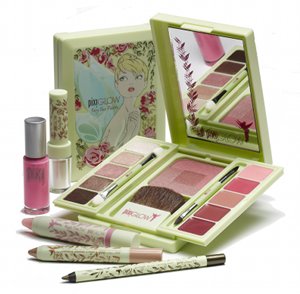
The PixiGlow Collection sold only at Target
Photos: Target, Victoria’s Secret
At what age do girls begin wearing make up? Perhaps because adult women are spending less on beauty products cosmetics makers are increasingly targeting tween girls between nine and twelve as well as older teens aged 13 to 17. Nearly half of young girls and many of their parents, however, don’t think the girls are old enough to wear make up, according to Teens’ and Tweens’ Beauty Market US December 2011, a report resulting from a Mintel survey.
From 2007 to 2009, girls aged 8 to 12 who said they regularly use mascara and eyeliner increased to 18 percent from 10 percent for mascara, to 15 percent from 9 percent for eyeliner and to 15 percent from 10 percent for lipstick, according to a new report from the NPD Group, a consumer research company. Women, on the other hand, are wearing less make up. Perhaps because of the downturn in the economy women appear to be cutting back on beauty products to save money and unemployed women may be less inclined to apply make up every morning, according to the NPD report.
Researchers at Mintel believe marketers who want to win over young shoppers should offer products that are subtle in appearance while at the same time safe for young skin; they believe that body lotion and nail polish are the most likely to gain acceptance among have tweens and their parents.
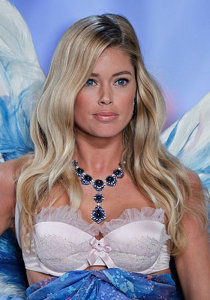
A Victoria’s Secret runway model with “wings”
Responses to the survey indicate teens like CoverGirl, Maybelline, Wet n Wild, Victoria’s Secret and Avon products while tweens favor Bath & Body Works for body lotion. A spokesperson for Victoria’s Secret replied to an email question about the company’s percentage of beauty products sales to girls aged nine to seventeen and best selling products for this market segment as follows: “Unfortunately I’m unable to provide this information.”
Two relative newcomers targeting young girls with affordable products were mentioned in the Mintel report, Geogirl, a line sold at WalMart and promoted as environmentally responsible; and PixiGlow, inspired by Tinker Bell and sold at Target stores.
Petra Strand, creator of the Pixi cosmetics line, teamed with The Walt Disney Co. to design the PixiGlow collection. To develop the vintage look of the line Strand worked closely with character artist John Quinn. Products priced between $8 and $34 are available online are are expected to become available at Target stores beginning March 2012. According to the retailer’s website, the PixiGlow extension line offers six color cosmetics exclusively at Target: Catching Shadows Crayon ($18), Fairy Dust ($14), Fairy Face Palette ($34), Magic Tink Tint ($16), Straight On ‘til Morning Liner ($15), and Pirouette Pink Nail Colour ($8).
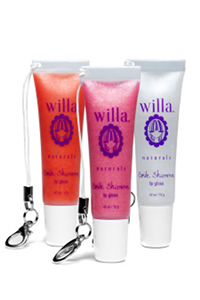
Willa lip gloss trio
“While I can’t say exactly what our best selling tween/teen beauty product is, I can tell you that Target offers a range of affordable cosmetics that appeal to tweens who are developing their individual style and beginning to experiment with makeup. Brands that appeal to the tween guest include Target’s exclusive Hello Kitty beauty collection, Caboodles, Wet & Wild and e.l.f. We also anticipate that the forthcoming tween natural skincare line Willa will be popular, said Evan Miller, spokesperson for Target. “PixiGlow, while created with a more mature beauty guest in mind, does appeal to our younger guest as well because of the link to Tinkerbell and Disney.”
According to the Mintel report, the least frequent users of makeup were tween girls between 9 and 12 and the most frequent daily users of cosmetics were those aged 15 to 17.
Posted by Elena del Valle on February 13, 2012
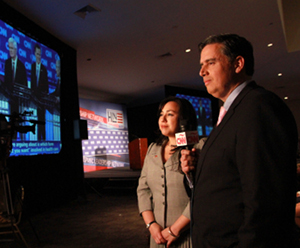
CNN en espanol news staff covering 2012 presidential debates
Photos: CNNenEspanol, Stagnito Media
The changes in media that deepened with the Great Recession and the demise of the traditional profit model will continue; social media and citizen journalism will likely impact media; and media channels are expected to further evolve in 2012, likely merging digital and social media into the mix, and continuing the development of media hybrids, according to a recently released Vocus report.
Vocus analysts believe that last year media experienced “an evolutionary revival.” While more newspapers closed last year (152) than the previous year (151) and hundreds of staff were left jobless there were 201 launches, 158 online and 43 in print. The new channels, many of them focused on local happenings, are likely to be home to young and digitally savvy staff.
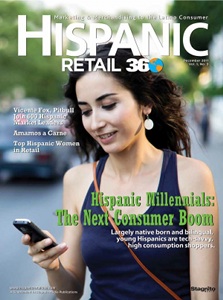
Hispanic Retail 360 December 2011 cover
The effect of the economic downturn was milder on magazines than on papers last year although there were very few national print magazine launches. Lucky Peach, Hispanic Retail 360 and The Social Media Monthly were cited in the report. Executives of Hispanic Retail 360, launched April 2011 by Stagnito Media as a continuation of the company’s annual conference by the same name, plan to publish four issues in 2012. The 36-page magazine, edited by Don Longo and produced by four staff, is divided into 60 percent editorial and 40 percent ads. It sells for $50 per year.
At the same time 50 new online only magazines began publishing in 2011. While many worried that the iPad would signal the end of magazines the report speculates the device may be saving magazines because people are looking for digital content to read on their tablets.
In 2011, streaming of television programs online was growing and there was growth in television and television related websites for Hispanics, according to the report. Several major TV networks launched websites targeting the Spanish dominant Hispanic population. CNN launched CNNenEspanol. com and Fox News launched Fox News Latino. NBC may launch NBCLatino.com this year.
Last year, News Corp., Fox’s parent company, launched Fox Hispanic Media, which encompasses Fox Deportes, Utillisima and Nat Geo Mundo, a Spanish-language National Geographic channel. NBC established Hispanic at NBC, an integrated sales/marketing division and research platform called.

Don Longo, editor, Hispanic Retail 360
The Spanish dominant market has been targeted by some local news sites. For example, the El Paso Times offers SomosFrontera.com; Patch.com offers Latino oriented editions in Southern California. Online Hulu launched Hulu Latino with Spanish language soap operas and other programs from Univision, Estrella TV, Galavision, Azteca America, and Telefutura (see Hulu targets U.S. Spanish speakers ). Overall, the researchers estimate there will be strong competition between television and other news sources online.
There was an increase of 240 million radio listeners 12 and older in 2011. Online radio use increased and the favorite format seems to be, if last year is any indication, news and talk shows, according to the report.
Blogs and bloggers have found acceptance and in some cases popular followings. Last year’s growth in blogs was mainly in the consumer sector, especially blogs about domestic life, parenting and cooking as well as professionals and companies, according to the report.
The State of the Media Report 2012 Evolving and Merging, an 18-page report, was compiled and written by Katrina M. Mendolera of Vocus, a provider of cloud-based marketing and public relations software. The report was the third annual State of the Media Report produced by the Vocus Media Research Team who predict that in 2012, cultivation and implementation will continue along with new ideas and trends. Print and broadcast will be enhanced into “shinier, newfangled versions that now incorporate all the elements of new and social media.”



























